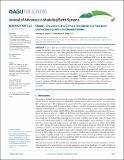Clouds, Circulation, and Climate Sensitivity in a Radiative-Convective Equilibrium Channel Model
Author(s)
Cronin, Timothy Wallace; Wing, Allison A.
DownloadCronin_et_al-2017-Journal_of_Advances_in_Modeling_Earth_Systems.pdf (2.109Mb)
PUBLISHER_CC
Publisher with Creative Commons License
Creative Commons Attribution
Terms of use
Metadata
Show full item recordAbstract
Tropical cloud and circulation changes are large sources of uncertainty in future climate change. This problem owes partly to the scale separation between large-scale tropical dynamics (~104km) and convective dynamics (~7 km), which generally requires parameterizing convection in models that resolve large-scale dynamics, or parameterizing (or omitting) large-scale dynamics in models that permit convection. Here we discuss simulations of radiative-convective equilibrium (RCE) across a wide range of surface temperatures in long-channel geometry—where the domain size and resolution marginally resolve both large-scale dynamics and convection. Self-aggregation of convection in these simulations spontaneously produces realistic dynamical regimes of large-scale vertical motion. The circulation weakens with surface warming but changes in the degree of self-aggregation depend on the metric that is used; there is no obvious trend in aggregation with warming. Surface warming causes an upward shift and decrease in area of high clouds, and a sharp decline in midlevel clouds, but no systematic trend in low cloud cover. We introduce a method for approximate radiative kernel feedback analysis in RCE, and apply it to both simulations in long-channel geometry and in a smaller square domain. The kernel-corrected cloud feedback is positive but its magnitude varies across temperatures. Compared to simulations that do not have aggregation, there is a more negative net feedback due to the effects of aggregation on relative humidity and cloud cover. These results are consistent with the hypothesis that self-aggregation moderately reduces climate sensitivity.
Date issued
2017-12Department
Massachusetts Institute of Technology. Department of Earth, Atmospheric, and Planetary SciencesJournal
Journal of Advances in Modeling Earth Systems
Publisher
American Geophysical Union (AGU)
Citation
Cronin, Timothy W., and Allison A. Wing. “Clouds, Circulation, and Climate Sensitivity in a Radiative-Convective Equilibrium Channel Model.” Journal of Advances in Modeling Earth Systems 9, 8 (December 2017): 2883–2905 © 2017 The Authors
Version: Final published version
ISSN
1942-2466